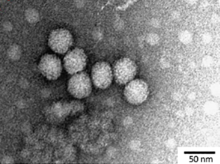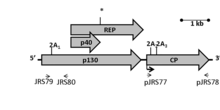Carmotetraviridae
Carmotetraviridae is a family of viruses; there is currently only one genus in this family, Alphacarmotetravirus, and one species in this genus, the type species Providence virus. Lepidopteran insects serve as natural hosts.[1][2]
| Alphacarmotetravirus | |
|---|---|
 | |
| Transmission electron micrograph of providence virus (PrV) virion | |
| Virus classification | |
| (unranked): | Virus |
| Realm: | Riboviria |
| Kingdom: | Orthornavirae |
| Phylum: | Kitrinoviricota |
| Class: | Tolucaviricetes |
| Order: | Tolivirales |
| Family: | Carmotetraviridae |
| Genus: | Alphacarmotetravirus |
| Type species | |
| Providence virus | |
Taxonomy
Group: ssRNA(+)
- Family: Carmotetraviridae
- Genus: Alphacarmotetravirus
- Providence virus
Structure

Viruses in Carmotetraviridae are non-enveloped, with icosahedral geometries, and T=4 symmetry. The diameter is around 40 nm. Genomes are linear, around 6.1kb in length. The genome codes for 2 proteins, and has 3 open reading frames.[1]
| Genus | Structure | Symmetry | Capsid | Genomic arrangement | Genomic segmentation |
|---|---|---|---|---|---|
| Alphacarmotetravirus | Icosahedral | T=4 | Non-enveloped | Linear |
Life cycle
Viral replication is cytoplasmic. Entry into the host cell is achieved by penetration into the host cell. Replication follows the positive stranded RNA virus replication model. Positive stranded RNA virus transcription is the method of transcription. Translation takes place by suppression of termination. Lepidopteran insects serve as the natural host. Transmission routes are oral.[1]
| Genus | Host details | Tissue tropism | Entry details | Release details | Replication site | Assembly site | Transmission |
|---|---|---|---|---|---|---|---|
| Alphacarmotetravirus | Lepidopteran insects | Midgut | Unknown | Unknown | Cytoplasm | Cytoplasm | Oral |
References
- "Viral Zone". ExPASy. Retrieved 13 August 2015.
- ICTV. "Virus Taxonomy: 2014 Release". Retrieved 23 November 2015.